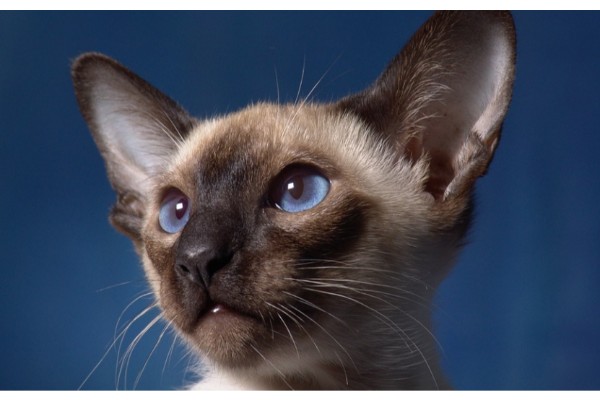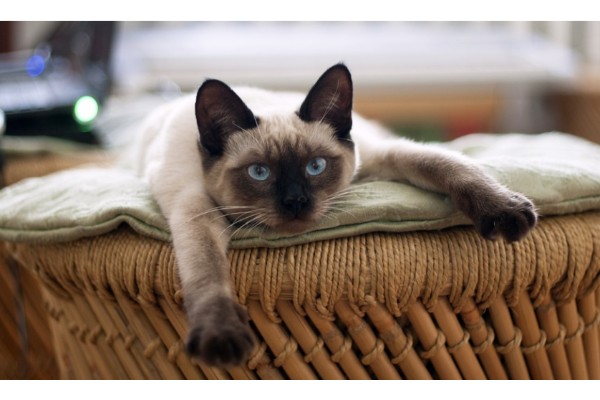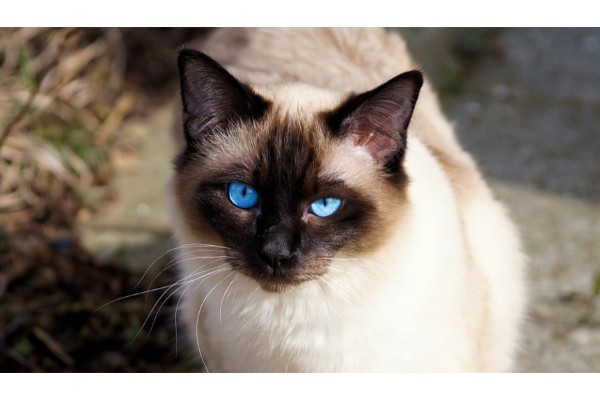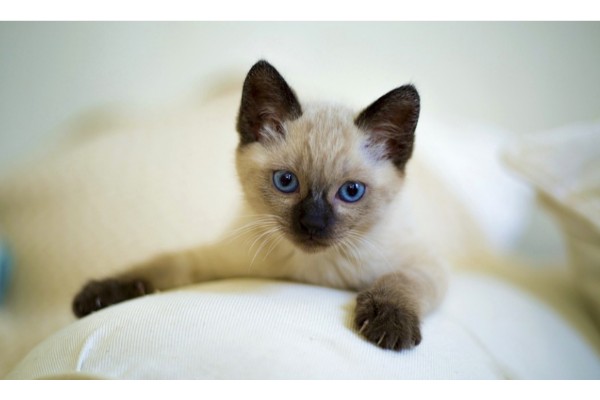Yes, the Siamese cat is considered to be hypoallergenic, because it is not a heavy shedder. However, you also have to know there is no completely hypoallergenic cat, so there still stands a chance to get allergic if you want to have a Siamese cat.
Table of Contents
- What Are People Allergic To?
- No Cat Is Completely Hypoallergenic
- Are Siamese Cats Hypoallergenic?
- Do Siamese Cats Cause Severe Allergic Reactions?
- Do Siamese Cats Shed Little?
- Can You Live With A Siamese Cat?
- How To Minimize Cat Allergens
- Which Cat Breed Is Ideal If You Have Allergies?
- How To Deal With Cat Allergies
- Conclusion
What Are People Allergic To?
There is a widespread misconception that people with cat allergies react to feline hair. People who have allergies actually react to the sebaceous glands of cats, specifically the Fel d 1 protein. This means that the allergens are present in a cat’s:
- Urine and feces
- Saliva
- Tears
- Mucous
- Skin and dander
Studies show that 80 to 95% of people who suffer from cat allergies react to Fel d 1 protein. Fel d 2 and Fel d 3 proteins, which are also produced by the sebaceous glands of cats, rarely cause an allergic reaction in people. There are no cat breeds that are hypoallergenic because all cats, regardless of breed, hair length, or shedding frequency, produce these proteins.

No Cat Is Completely Hypoallergenic
Contrary to popular belief, you aren’t just bothered by the cat’s hair. The Fel d 1 protein, which is only found in and on cats and dogs, is what actually causes allergy sufferers to sneeze. The base of a cat’s hair contains this protein, as do its saliva, urine, and feces.
Cats typically have good control over where their saliva and poop go, so these methods of dispersing the noxious Fel d 1 protein are not a problem. Typically, the hair is to blame. Hair gets on every surface of your home (and probably your car, too) if you’ve ever owned or been around a pet that sheds.
No cat is truly and completely hypoallergenic because they all produce this protein to some degree. However, some cat breeds produce less of this protein or simply shed less than other cat breeds.
Are Siamese Cats Hypoallergenic?
No cat, as previously stated, is truly hypoallergenic. Our Siamese friend is unfortunately included in this. However, because the Siamese does not shed much, it might be a good choice for someone who typically has cat allergies.
In 2009, the Delaware-based biotechnology company Allerca asserted that it had created a cat that was completely hypoallergenic. The outcomes weren’t exactly stellar.
It appears unlikely that gene editing will create such an animal anytime soon.
Do Siamese Cats Cause Severe Allergic Reactions?
Due to the fact that some cat breeds, such as Siamese cats, Bengals, Russian Blues, Burmese, Sphynx, and Siberian cats, don’t produce significant amounts of the Fel d1 protein, they may cause milder reactions in allergy sufferers. Siamese cats also shed less and produce relatively little of this protein. Cats with less shedding appear to make better pets for cat parents who are allergic to cat dander and fur.
Do Siamese Cats Shed Little?
The amount of hair a pet sheds is another aspect that affects how hypoallergenic it is. The Fel d 1 protein is typically released in greater quantities as shedding increases. In this instance, Siamese cats produce less of that protein and shed less than other cat breeds. They still shed a little, though, which makes them not the most “hypoallergenic” cat breed out there.

Can You Live With A Siamese Cat?
If you have mild cat allergies, you can live with a Siamese cat without experiencing severe reactions. Antihistamines like loratadine can help control symptoms such as:
- Runny nose
- Watery eyes
- Sneezing
- Throat irritation
- Itchy skin
It is possible to avoid medication altogether if you take some precautions, namely:
- Washing linens more frequently
- Not letting your cat sleep in your bed or restricting their access to the bedroom
- Washing your clothes often
- Vacuuming and dusting daily
- Keeping washable covers on the furniture
- Grooming your cat outdoors while wearing gloves and face masks or asking someone else to handle grooming
Doctors don’t recommend adopting a cat if you experience severe symptoms, including:
- Vomiting
- Swelling
- Severe asthma
- Difficulty swallowing
How To Minimize Cat Allergens
If you give your Siamese cat the proper care, you can drastically reduce shedding and the amount of dander (and allergens) in your home. You should:
- Groom your cat regularly
- Treat underlying health issues
- Invest in quality food
How To Groom A Siamese Cat
Regular grooming aids in eliminating dead hair and skin while preventing the spread of allergens throughout your home. It should work if you brush your cat several times per week.
Here are some tips you should follow:
- Brush your Siamese outside—Brushing your Siamese cat outside will help keep dead fur and dander out of your home because cat hair is so fine that it flies everywhere. Always use a soft bristle or rubber brush and brush in the direction of the hair growth. You can also ask someone who is not allergic to cats to do the brushing for you
- Wipe your cat’s fur with a damp cloth—This will ensure that the remaining dead fur and dander stick to the cloth
- Bathe your Siamese regularly—One bath per week is recommended for your feline friend. Start bathing them while your cat is still a kitten so they can get used to the whole process
How Can Health Niggles Affect Shedding
Siamese cats are prone to two conditions that can cause excessive shedding:
- Psychogenic cat alopecia—Siamese cats are prone to compulsive behavior, such as overgrooming, which can result in patchy hair loss. Chronic stress, psychological trauma, anxiety, and boredom are the main contributors to this ailment. The treatment typically involves lifestyle changes and antidepressants
- Feline hyperesthesia syndrome—This condition, also known as the twitch-skin syndrome, is prevalent in Siamese, Burmese, and Abyssinian cats. Their excessive licking, biting, and scratching can result in open wounds because their skin becomes incredibly sensitive. The condition can be caused by:
- Fungal infections
- Parasites
- Food allergies
- Allergies to particles in the environment
High-quality Cat Food Can Help
An inadequate diet can increase shedding in cats and your exposure to allergens. The following ingredients commonly found in commercial cat food are particularly problematic:
- Additives—artificial flavoring and colorants
- Common allergens—eggs, dairy, beef
- Filler ingredients—grains, such as rice, sweetcorn, corn, wheat, soya, etc.
You should give your cat food that closely resembles their natural feeding schedule if you want to lessen shedding and prevent many skin-related problems. In nature, cats hunt and eat small animals, like birds, mice, and slugs, so the food you feed them should mimic that, which means it should contain:
- Sufficient amounts of suitable protein—Because meat is the only source of the essential amino acids—such as taurine, arginine, and histidine—that cats require to maintain healthy skin and fur, cat food should have at least 50% animal protein. Additionally aiding in the development of muscles and bones, amino acids also support the immune system. Cats are carnivores, so a plant-based diet and proteins from vegetables are not suitable for their digestive system. The best sources of protein for felines are lean meats (such as chicken, liver, and turkey) or fish
- Moderate amounts of fat—Animal fat offers omega-3 and omega-6 fatty acids, which promote a healthy, shiny coat and less shedding in addition to being an excellent additional source of energy for felines. A proper inflammatory response and wound healing depend on fat, which also aids in the treatment of dry skin and is essential for metabolic processes. Tuna, sardine, salmon, and mackerel are good sources of essential fatty acids
- Vitamins and minerals—Cats need selenium, vitamin E, and vitamin B complex for healthy coats because they help the skin retain moisture. All the essential vitamins and minerals can be found in meat

Which Is Better For A Siamese Cat’s Fur: Wet Food Or Dry Food?
Many vets recommend choosing wet cat food over kibbles and feeding your kitty at least two portions of canned food a day because this diet:
- Keeps felines hydrated
- Lowers the chance of urinary tract problems
- Contains more protein
- Helps keep your cat’s skin hydrated
Wet food typically contains about 70% moisture, compared to only 10% moisture in dry food. This is important because cats don’t have a strong thirst drive and dry food can dehydrate them. Dehydration can cause dander buildup, a loss of skin elasticity, and fur loss.
Dehydration can result in more severe health problems, such as urinary infections (like, for example, struvite crystals and cystitis) and constipation.
Which Cat Breed Is Ideal If You Have Allergies?
We have already discussed the lack of a cat that is completely hypoallergenic. But if you want a cat that people with all sorts of allergies can at least tolerate distantly, there are specific qualities to look for in a cat.
Long-Haired
It makes sense that cats with shorter hair would be more hypoallergenic than cats with long hair. The opposite is actually supported by science. The length of the hair shouldn’t be too important since we already know that people aren’t always allergic to the cat’s hair.
It has been discovered that longer cat hair helps the Fel d 1 protein stay contained in the skin and hair length. This indicates that less protein is released into the atmosphere or onto other surfaces.
Low Shedding
Less shedding cats are less likely to release the Fel d 1 protein into their surroundings. So it stands to reason that a low-shedding cat would have better hypoallergenic properties than a high-shedding cat.
Female
The Fel d 1 that women produce is lower than that of their male counterparts. Because of this, purchasing a female cat is advised if you really want a cat and have only mild cat allergies.
Outdoor
The fact that the offending animal resides in the home contributes in part to why people experience allergic reactions to pets. When your cat lives inside, it is impossible to prevent the Fel d 1 protein from getting everywhere. Maintaining your cat outside, where they can spread that protein around without bothering you or your guests, is one simple way to experience fewer allergic reactions to cat hair.
The Best Hypoallergenic Cat Breeds
For people looking for the most hypoallergenic cats available, look into these cat breeds:
Sphynx
Balinese-Javanese
Siberia
Devon Rex
Cats That Are The Worst For Allergies
If you want to avoid cats that are extremely bad for your cat allergies, stay away from these breeds:
Persia
British Longhai
Maine Coon
Long Haired Manx
How To Deal With Cat Allergies
When you are aware that cats cause severe allergic reactions in you, it is best to stop trying and avoid cats altogether. Your health is not worth putting at risk!
However, if your allergic reaction to cats is only slight, you can coexist peacefully with your cherished feline. Here are a few quick tips:
Vacuum everywhere your cat is, often
Change and wash linens frequently
Establish a “cat-free” zone where you know you can find respite
Change air filters in the HVAC system
Wash clothes when you play with the cat
Brush your cat often the outdoors
Conclusion
When you adore cats but are allergic to them, life can be ironically challenging. You might still be able to own a cat and stay healthy, depending on how severe your allergies are. One way is to buy a cat that has hypoallergenic traits, such as a Siamese cat. Even though no cat is completely hypoallergenic, they rank very low on the list of cat breeds that allergy sufferers find to be offensive.
